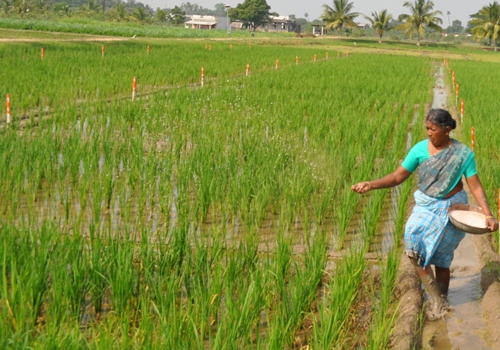Application of inorganic fertilizers
- Apply fertilizer nutrients as per soil test recommendations
- N dose may be through Leaf Color Chart (LCC)
- P & K may be through Site Specific Nutrition Management by Omission plot technique (Ref. Appendix II)
- If the above recommendation are not able to be followed, adopt blanket recommendation as follows:
| Nutrients |
N |
P2O5 |
K2O |
 |
| (kg/ha) |
| Short duration varieties (dry season) |
|
|
|
| a) Cauvery delta & Coimbatore tract |
150 |
50 |
50 |
| b) For other tracts |
120 |
40 |
40 |
| Medium and long duration varieties (wet season) |
150 |
50 |
50 |
| Hybrid rice |
175 |
60 |
60 |
| Low N responsive cultivars (like Improved White Ponni) |
75* |
50 |
50 |
| |
|
|
|
| |
|
|
|
|
*For Ponni, N should be applied in three splits at AT, PI and H stages** in addition to GLM or FYM application.
**Phenological stages of rice (days after sowing)
| Stages |
Short (105) |
Medium (135) |
Long (150) |
| Active Tillering (AT) |
35-40 |
50-55 |
55-60 |
| Panicle Initiation (PI) |
45-50 |
70-75 |
85-90 |
| Heading (H) |
70-75 |
100-105 |
115-120 |
Application of P fertilizer
- P may be applied as basal and incorporated.
- When the green manure is applied, rock phosphate can be used as a cheap source of P fertilizer. If rock phosphate is applied, the succeeding rice crop need not be supplied with P. Application of rock phosphate + single super phosphate or DAP mixed in different proportions (75:25 or 50:50) is equally effective as SSP or DAP alone.
Split application of N and K
- Apply N and K in four equal splits viz., basal, tillering, panicle initiation and heading stages.
- Tillering and Panicle initiation periods are crucial and should not be reduced with the recommended quantity.
- N management through LCC may be adopted wherever chart is available as given below
|

